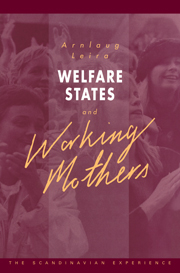Book contents
- Frontmatter
- Contents
- List of figures
- List of tables
- Preface and acknowledgements
- List of abbreviations
- 1 Introduction
- 2 Models of motherhood
- 3 Welfare states and working mothers: the Scandinavian experience
- 4 The collectivization of childcare
- 5 Mothers, markets and the state
- 6 Modes of mothering
- 7 Carer state and carer careers
- Notes
- References
- Index
4 - The collectivization of childcare
Published online by Cambridge University Press: 05 December 2011
- Frontmatter
- Contents
- List of figures
- List of tables
- Preface and acknowledgements
- List of abbreviations
- 1 Introduction
- 2 Models of motherhood
- 3 Welfare states and working mothers: the Scandinavian experience
- 4 The collectivization of childcare
- 5 Mothers, markets and the state
- 6 Modes of mothering
- 7 Carer state and carer careers
- Notes
- References
- Index
Summary
Welfare state and early childhood care
Up to the end of World War II state policies for early childhood education and care were virtually nonexistent in Norway. Only in cases of severe neglect or abuse, or if a child had been abandoned, orphaned or was temporarily lacking an economic provider, was it mandatory for public authorities to intervene (Seip 1987). Otherwise the state did not interfere with the everyday arrangements for the youngest children. Rearing and caring was left to the family.
In chapter 4 I examine the political history of early childhood education and care in Norway in the period 1945–85, dealing first with the deliberations preceding legislation in 1975, and then with the development of services in the next decade.
My analysis focuses on the reconstitution of the state–family relationship as evidenced in the introduction of national policies for the early childhood years. Childcare and upbringing being primarily the mothers' responsibility, state-sponsored programmes for pre-school children signalled a change in the relationship between the state and mothers. Special attention is given to the part played by the state as initiator or instrument of change as regards the carer aspects of motherhood. Whether explicitly stated or not, childcare policies always contain certain assumptions about the family and about the parent–child relationship. Which models of motherhood did the Norwegian policies promote?
The chapter centres on two issues of particular importance to my analysis of motherhood change: how was state responsibility for ‘generational reproduction’ defined?
- Type
- Chapter
- Information
- Welfare States and Working MothersThe Scandinavian Experience, pp. 64 - 96Publisher: Cambridge University PressPrint publication year: 1992



